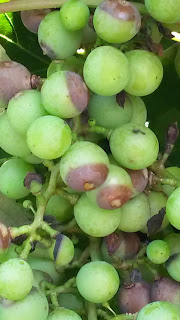I have received several emails about black rot recently. With the frequency of rains we observed so far, it is not surprising to see small amount of black rot even if you had a very good coverage of fungicide. Typically black rot starts off as brown discoloration on the berry, and associated with production of fruiting bodies which are often look like black dots (the size of ground black pepper?). The picture above is not the best, but you see black dots on the one at the top of the picture. Eventually, the infected berry will become hard and dry mummified berry with a lots of fruiting bodies, which you can see here and there in the picture.
If you are seeing something like the picture above, chances are the infection happened at least two weeks ago when berries were susceptible to the infection by black rot pathogen (and so as by powdery mildew or downy mildew pathogen). I can say that because it takes about 2 weeks after infection for black rot pathogen to cause symptoms. However, at this point of the season, your berries are matured and should be resistant to new infections. Thus, spores from the infected berries should not cause further infection on healthy berries. But I should note that if the vine had multiple infection events in the past, you may see increase in black rot. Often time, infection happened at the end of the critical period for black rot tends to take time to show its symptom. However, there is nothing we can do about the infected berries.
So, the question is what to do. Since it should not cause further new infections on berries, I do not see the need for a black rot specific fungicide application. However, if you insist, or if you have a late maturing varieties that may still be in the edge of the critical period, or more importantly, if you have a concern on ripe rot, you can include either a QoI (Abound, Flint, etc) or DMI (Rally, Elite, etc) to your next fungicide application. Please note that captan won’t be effective against black rot. Unlike black rot, grape berries seem to be susceptible to ripe rot pathogen throughout the season.
If you are considering removal of infected berries, you may want not only to remove them from the vine, but also take the infected berries out from your vineyard. Even if you drop them on the ground, these infected berries will survive over the winter and become a source of spores in coming spring. This pathogen can produce airborne spores, thus, spores on the ground can be blown off to leaves. The mummies are small in size, thus, I doubt that a lawn mower will break them down. Moreover, sending people to pick infected berry will cost you quite a bit.
Thus, what I would do is just leave them as is. The healthy berries won’t get new infection, thus, I do not see the risk on yield reduction beyond what have been infected at this point. By the time of harvest, the infected berries should become dry mummified berries that are easy to spot on a sorting table, and even if they are mixed into a must, this disease is not known to affect the quality of wine.
Lastly, if you had observed a fair amount of black rot this year, please make sure to have a good protection program next year, especially if it ended up like a rainy one like this year.

